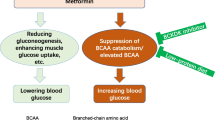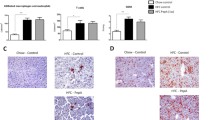Abstract
Aims/hypothesis
Cathepsin S (CatS) belongs to a family of proteases that have been implicated in several disease processes. We previously identified CatS as a protein that is markedly overexpressed in adipose tissue of obese individuals and downregulated after weight loss and amelioration of glycaemic status induced by gastric bypass surgery. This prompted us to test whether the protease contributes to the pathogenesis of type 2 diabetes using mouse models with CatS inactivation.
Methods
CatS knockout mice and wild-type mice treated with orally active small-molecule CatS inhibitors were fed chow or high-fat diets and explored for change in glycaemic status.
Results
CatS deletion induced a robust reduction in blood glucose, which was preserved in diet-induced obesity and with ageing and was recapitulated with CatS inhibition in obese mice. In vivo testing of glucose tolerance, insulin sensitivity and glycaemic response to gluconeogenic substrates revealed that CatS suppression reduced hepatic glucose production despite there being no improvement in insulin sensitivity. This phenotype relied on downregulation of gluconeogenic gene expression in liver and a lower rate of hepatocellular respiration. Mechanistically, we found that the protein ‘regulated in development and DNA damage response 1’ (REDD1), a factor potentially implicated in reduction of respiratory chain activity, was overexpressed in the liver of mice with CatS deficiency.
Conclusions/interpretation
Our results revealed an unexpected metabolic effect of CatS in promoting pro-diabetic alterations in the liver. CatS inhibitors currently proposed for treatment of autoimmune diseases could help to lower hepatic glucose output in obese individuals at risk for type 2 diabetes.





Similar content being viewed by others
Abbreviations
- CatS:
-
Cathepsin S
- CatS-KO:
-
Cathepsin S knockout
- FCCP:
-
Trifluorocarbonylcyanide phenylhydrazone
- HFD:
-
High-fat diet
- MEF:
-
Mouse embryo fibroblast
- OCR:
-
Oxygen consumption rate
- REDD1:
-
Regulated in development and DNA damage response 1
- RQ:
-
Respiratory quotient
- WT:
-
Wild type
References
Taleb S, Lacasa D, Bastard JP et al (2005) Cathepsin S, a novel biomarker of adiposity: relevance to atherogenesis. FASEB J 19:1540–1542
Lecaille F, Kaleta J, Bromme D (2002) Human and parasitic papain-like cysteine proteases: their role in physiology and pathology and recent developments in inhibitor design. Chem Rev 102:4459–4488
Reiser J, Adair B, Reinheckel T (2010) Specialized roles for cysteine cathepsins in health and disease. J Clin Invest 120:3421–3431
Taleb S, Cancello R, Poitou C et al (2006) Weight loss reduces adipose tissue cathepsin S and its circulating levels in morbidly obese women. J Clin Endocrinol Metab 91:1042–1047
Naour N, Rouault C, Fellahi S et al (2010) Cathepsins in human obesity: changes in energy balance predominantly affect cathepsin s in adipose tissue and in circulation. J Clin Endocrinol Metab 95:1861–1868
Riese RJ, Wolf PR, Bromme D et al (1996) Essential role for cathepsin S in MHC class II-associated invariant chain processing and peptide loading. Immunity 4:357–366
Shi GP, Villadangos JA, Dranoff G et al (1999) Cathepsin S required for normal MHC class II peptide loading and germinal center development. Immunity 10:197–206
Nakagawa TY, Brissette WH, Lira PD et al (1999) Impaired invariant chain degradation and antigen presentation and diminished collagen-induced arthritis in cathepsin S null mice. Immunity 10:207–217
Saegusa K, Ishimaru N, Yanagi K et al (2002) Cathepsin S inhibitor prevents autoantigen presentation and autoimmunity. J Clin Invest 110:361–369
Palermo C, Joyce JA (2008) Cysteine cathepsin proteases as pharmacological targets in cancer. Trends Pharmacol Sci 29:22–28
Lee-Dutra A, Wiener DK, Sun S (2011) Cathepsin S inhibitors: 2004–2010. Expert Opin Ther Pat 21:311–337
Baugh M, Black D, Westwood P et al (2011) Therapeutic dosing of an orally active, selective cathepsin S inhibitor suppresses disease in models of autoimmunity. J Autoimmun 36:201–209
Deschamps K, Cromlish W, Weicker S et al (2011) Genetic and pharmacological evaluation of cathepsin s in a mouse model of asthma. Am J Respir Cell Mol Biol 45:81–87
Wang B, Sun J, Kitamoto S et al (2006) Cathepsin S controls angiogenesis and tumor growth via matrix-derived angiogenic factors. J Biol Chem 281:6020–6029
Burden RE, Gormley JA, Jaquin TJ et al (2009) Antibody-mediated inhibition of cathepsin S blocks colorectal tumor invasion and angiogenesis. Clin Cancer Res 15:6042–6051
Ward C, Kuehn D, Burden RE et al (2010) Antibody targeting of cathepsin S inhibits angiogenesis and synergistically enhances anti-VEGF. PLoS One 5
Sukhova GK, Shi GP, Simon DI et al (1998) Expression of the elastolytic cathepsins S and K in human atheroma and regulation of their production in smooth muscle cells. J Clin Invest 102:576–583
Sukhova GK, Zhang Y, Pan JH et al (2003) Deficiency of cathepsin S reduces atherosclerosis in LDL receptor-deficient mice. J Clin Invest 111:897–906
Rodgers KJ, Watkins DJ, Miller AL et al (2006) Destabilizing role of cathepsin S in murine atherosclerotic plaques. Arterioscler Thromb Vasc Biol 26:851–856
Jobs E, Ingelsson E, Riserus U et al (2011) Association between serum cathepsin S and mortality in older adults. JAMA 306:1113–1121
Liu J, Ma L, Yang J et al (2006) Increased serum cathepsin S in patients with atherosclerosis and diabetes. Atherosclerosis 186:411–419
Jobs E, Riserus U, Ingelsson E et al (2013) Serum cathepsin S is associated with decreased insulin sensitivity and the development of diabetes type 2 in a community-based cohort of elderly men. Diabetes Care 36:163–165
Burcelin R, Crivelli V, Dacosta A et al (2002) Heterogeneous metabolic adaptation of C57BL/6J mice to high-fat diet. Am J Physiol Endocrinol Metab 282:E834–E842
Samokhin AO, Lythgo PA, Gauthier JY et al (2010) Pharmacological inhibition of cathepsin S decreases atherosclerotic lesions in Apoe-/- mice. J Cardiovasc Pharmacol 56:98–105
Rupanagudi KV, Kulkarni OP, Lichtnekert J et al (2013) Cathepsin S inhibition suppresses systemic lupus erythematosus and lupus nephritis because cathepsin S is essential for MHC class II-mediated CD4 T cell and B cell priming. Ann Rheum Dis. doi:10.1136/annrheumdis-2013-203717
Sulpice T, Prunet-Marcassus B, Molveaux C et al (2009) An adiponectin-like molecule with antidiabetic properties. Endocrinology 150:4493–4501
Weir JB (1949) New methods for calculating metabolic rate with special reference to protein metabolism. J Physiol 109:1–9
Subramanian A, Tamayo P, Mootha VK et al (2005) Gene set enrichment analysis: a knowledge-based approach for interpreting genome-wide expression profiles. Proc Natl Acad Sci U S A 102:15545–15550
Ben Sahra I, Regazzetti C, Robert G et al (2011) Metformin, independent of AMPK, induces mTOR inhibition and cell-cycle arrest through REDD1. Cancer Res 71:4366–4372
Mutel E, Gautier-Stein A, Abdul-Wahed A et al (2011) Control of blood glucose in the absence of hepatic glucose production during prolonged fasting in mice: induction of renal and intestinal gluconeogenesis by glucagon. Diabetes 60:3121–3131
Horak P, Crawford AR, Vadysirisack DD et al (2010) Negative feedback control of HIF-1 through REDD1-regulated ROS suppresses tumorigenesis. Proc Natl Acad Sci U S A 107:4675–4680
Haslam DW, James WP (2005) Obesity. Lancet 366:1197–1209
Guh DP, Zhang W, Bansback N et al (2009) The incidence of co-morbidities related to obesity and overweight: a systematic review and meta-analysis. BMC Public Health 9:88
Yang M, Zhang Y, Pan J et al (2007) Cathepsin L activity controls adipogenesis and glucose tolerance. Nat Cell Biol 9:970–977
Funicello M, Novelli M, Ragni M et al (2007) Cathepsin K null mice show reduced adiposity during the rapid accumulation of fat stores. PLoS ONE 2:e683
Yang M, Sun J, Zhang T et al (2008) Deficiency and inhibition of cathepsin K reduce body weight gain and increase glucose metabolism in mice. Arterioscler Thromb Vasc Biol 28:2202–2208
Hua Y, Zhang Y, Dolence J et al (2013) Cathepsin k knockout mitigates high-fat diet-induced cardiac hypertrophy and contractile dysfunction. Diabetes 62:498–509
Nathan DM, Buse JB, Davidson MB et al (2009) Medical management of hyperglycemia in type 2 diabetes: a consensus algorithm for the initiation and adjustment of therapy: a consensus statement of the American Diabetes Association and the European Association for the Study of Diabetes. Diabetes Care 32:193–203
Shaw RJ, Lamia KA, Vasquez D et al (2005) The kinase LKB1 mediates glucose homeostasis in liver and therapeutic effects of metformin. Science 310:1642–1646
He L, Sabet A, Djedjos S et al (2009) Metformin and insulin suppress hepatic gluconeogenesis through phosphorylation of CREB binding protein. Cell 137:635–646
Mithieux G, Guignot L, Bordet JC et al (2002) Intrahepatic mechanisms underlying the effect of metformin in decreasing basal glucose production in rats fed a high-fat diet. Diabetes 51:139–143
Owen MR, Doran E, Halestrap AP (2000) Evidence that metformin exerts its anti-diabetic effects through inhibition of complex 1 of the mitochondrial respiratory chain. Biochem J 348:607–614
Foretz M, Hebrard S, Leclerc J et al (2010) Metformin inhibits hepatic gluconeogenesis in mice independently of the LKB1/AMPK pathway via a decrease in hepatic energy state. J Clin Invest 120:2355–2369
Magnusson I, Rothman DL, Katz LD et al (1992) Increased rate of gluconeogenesis in type II diabetes mellitus. A 13C nuclear magnetic resonance study. J Clin Invest 90:1323–1327
Basu R, Barosa C, Jones J et al (2013) Pathogenesis of prediabetes: role of the liver in isolated fasting hyperglycemia and combined fasting and postprandial hyperglycemia. J Clin Endocrinol Metab 98:E409–E417
Edgerton DS, Johnson KM, Cherrington AD (2009) Current strategies for the inhibition of hepatic glucose production in type 2 diabetes. Front Biosci (Landmark Ed) 14:1169–1181
Acknowledgements
The authors thank the following individuals: N. Naour (Haute Autorité de Santé, Paris, France), who contributed to the early phases of this study; S. André (Inserm U872 Team 7, Paris, France) and S. V. Kaveri (Inserm U872 Team 16, Paris, France) for their help with the ovalbumin test and C. Magnan (CNRS EAC 4413, Paris, France), C. Cruciani-Guglielmacci (CNRS EAC 4413, Paris, France), A.-F. Burnol (Inserm U1016, Paris, France), G. Lalmanach (Inserm U1100, Tours, France), F. Andreelli (Inserm U872 Team7, Paris, France), G. Mithieux (Inserm U855, Lyon, France) and A. Mardinoglu (Chalmers University of Technology, Gothenburg, Sweden) for helpful discussions. We also thank S. Vannucci (Weill Cornell Medical College, New York, NY, USA) for commenting on the manuscript. We are grateful to F. Bost (Inserm U1062 Team 7, Nice, France) and L. W. Ellisen (Harvard Medical School, Boston, MA, USA) for giving us the opportunity to use Redd1−/− MEFs and to K. Lolmede (AdipoPhyt, Paris, France) for her crucial help in OxoPlate experiments. We thank J.-F. Bedel (Inserm U872 Team7, Paris, France) and F. Briand (Physiogenex, Toulouse, France) for their expert technical assistance.
Funding
This work was supported by the National Agency of Research (ANR OB-Cat), Inserm Transfert, Region Ile de France/CODDIM (grant to MG-M), Fondation pour la Recherche Medicale/Danone, European Union (FP7, ADAPT) and the National Institutes of Health of the USA (HL60942, HL81090, HL88547 to GPS).
Duality of interest
The authors declare that there is no duality of interest associated with this manuscript.
Contribution statement
MG-M, G-PS, TS and KC contributed to the conception and design of the study. J-CL and MP acquired, analysed and interpreted the data. VP, GO, NV, GH contributed to data acquisition. MG-M, J-CL and MP wrote the manuscript. All authors contributed to the review of the manuscript and approved the final version to be published. MG-M is the guarantor of this work, had full access to all the data in the study and takes responsibility for the integrity of the data and the accuracy of data analysis.
Author information
Authors and Affiliations
Corresponding author
Additional information
Jean-Charles Lafarge and Maria Pini contributed equally to this study.
Electronic supplementary material
Below is the link to the electronic supplementary material.
ESM Table 1
(PDF 167 kb)
ESM Table 2
(PDF 168 kb)
ESM Fig. 1
(PDF 166 kb)
Rights and permissions
About this article
Cite this article
Lafarge, JC., Pini, M., Pelloux, V. et al. Cathepsin S inhibition lowers blood glucose levels in mice. Diabetologia 57, 1674–1683 (2014). https://doi.org/10.1007/s00125-014-3280-2
Received:
Accepted:
Published:
Issue Date:
DOI: https://doi.org/10.1007/s00125-014-3280-2




